“Lithuania still remains among the European countries with the highest rates of COVID-19 infections but there are some positive news – the curve of the epidemic has started tilting downward and the weekly number of new cases has started to decrease. The fall is minus 20 percent, based on existing measures,” the minister said after a meeting of the Government Emergency Commission on Monday.
The commission had not discussed easing the lockdown on Monday, she said adding that the restrictions would be reviewed on January 17.
Bilotaite refused to specify the restrictions that might be relaxed saying that the decisions would be proposed by experts, and not by policymakers.
“To sum up, it can be said that we are definitely on the right path and it is necessary to maintain the existing restrictions, in particular in the light of some examples, for instance in the Czech Republic or Ireland, when the easing of restrictions after some improvements in the situation was followed by a surge in the epidemic curve,” the minister explained.
Meanwhile, Lithuania’s chief epidemiologist Loreta Asokliene pointed to declines in both the total number of new COVID-19 cases and in the rate of new infections. She warned, however, that those data concerned a short period of time.
“A week ago, the 14-day rate of new infections per 100,000 inhabitants was 1,226 cases and today, it is 1,005 cases, but this incidence rate is one of the highest across Europe. Another indicator – the rate of positive tests – shows a decline from 21 percent a week ago to 15 percent today,” she said.
As part of the nationwide lockdown, in effect until January 31, most shops and services are closed in Lithuania and there are restrictions on people's movements and gatherings.
